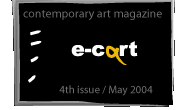































What happens when everything is design?
Markus Degerman
The announcement of Swedish Design Year 2005 comes like a sign from above on the heels of the increased focus on design in recent years. It is no exaggeration to claim that design has increasingly become a concept that reaches into ever more aspects of our world. Design seems to turn up just about everywhere and to intrude into most things. At times one might imagine that it is capable of saving parts of the country that are suffering an economic crisis or ensuring the prosperity of the entire country. Perhaps this is true? In the field of further education design seems to be hot at any rate. New courses with the word design somewhere in the title start up and more and more young people want to work in the field. The subject is given increasing space in the media too; from buying things to making them oneself. Perhaps the much-discussed step from an industrial society to a service society has had a noticeable effect and has moved our focus from production of hardware to software. Design, at any rate, seems to have been increasingly in the limelight in recent years. Why is this?
In a collection of articles entitled Consumer Culture and Postmodernism published in 1991, the British sociologist Mike Featherstone writes of how different social groups have influenced society and how we relate to the products that surround us. To summarize, he maintains that people working, for example, in advertising, fashion, design and media have helped to establish and spread a post-modern approach and post-modern products. Mike Featherstone calls this group of people the new cultural intermediaries and, in his view, they are recognizable by their interest in lifestyle, identity, appearance and life experiences. He claims that, in order to win influence in the ruling bourgeois culture, they make use of irony, eclecticism and a playful approach to symbols and codes. Here in Sweden their most obvious equivalents are Linda Skugge and the "Killing gänget".* Today this scenario is well known and hardly news. So that we can be fairly sure that we are living in a post-modern context in which eclecticism, lifestyle, taste and an understanding of symbols and codes are important. In the opinion of Mike Featherstone, when more and more people are occupied in mediating this culture, interest in its content increases. One indication of this is the fact that increasing numbers of lists, guides and programmes tell us where and how we are to do things. In the long run this will encroach on our everyday lives and we shall find ourselves in what is sometimes termed an aestheticized society.
In an aestheticized society one can maintain, to put it simply, that the visual dimension is more important than meaning. Thus, the value of an artefact is not, in the first instance, its value as a usable object but as a symbol. That a chair is comfortable to sit on is of less importance than what it looks like. To complicate the issue it is important to point out that even utility value can be aestheticized and that the symbolism also has meaning and can be interpreted. For example: to purchase a jacket intended for polar expeditions is not just a matter of buying the best possible jacket for actual winter wear in Sweden. Even the price, the appearance, the brand and the fact that one has chosen the symbol of "the best and warmest jacket" is significant. In other words, it is not the case that there is less "meaning" in the aestheticized context or that the utility value no longer exists. Rather, it is no longer possible to maintain that certain values and cultures are self-evidently better than others. It becomes, for example, difficult to speak of "high" culture as being better than popular culture or that the utility value of an item has nothing to do with its appearance or that certain areas of life are not influenced by culture. A great deal today can and is judged from some sort of perspective of beauty. What, for example, will happen with political issues when it becomes possible to use them just like any other lifestyle accessories; when one can adopt an ideology just as easily as putting on a jacket? The result of this change is that the connection between appearance, content and meaning has become very much more complicated than heretofore. So we need to ask what things mean from an aesthetic and symbolical perspective.
It is probably here that we find the explanation for the constant presence of the design concept. If our world has become aestheticized then design is obviously present everywhere and anywhere. If we now suppose that this is the way things are and that people, in various degrees, have realized this state of affairs, what trends can we then expect to meet? Since the groups that Mike Featherstone mentioned as the new cultural intermediaries know what is desirable in today's culture and, in turn, mediate this to a wider public, they can be said to be in a position of power. But at the same rate that a wider public accepts their message the mediated status sinks in that the knowledge is no longer exclusive. Things that everybody knows or has do not have the capital that is sought. Design as a phenomenon, a concept and an expression finds itself in the middle of this changeable system. As has been noted before, design has been presented as something valuable from different points of view and the designed object as more interesting and better that the "non-designed" item. Perhaps one may claim that the concept has been popularized. What will it mean, for example, if we get more design in Sweden? What is the difference between something that has been designed and something "non-designed" and what happens when everything is design? In a culture in which an item's utility value and function do not just comprise what is practically usable but also the item's symbolic utility it would seem to be even more important to recognize an object as "designed". In many instances this is reduced merely to appearance but there can be supplementary issues such as who did what, who produced the article and why something has been made in a particular way. As all this becomes popularized and thus universal the "designed" object becomes interesting from a sales point of view. In this way we can acquire more design in Sweden but, as this happens, there will be a change in the significance of what is obviously designed. Paradoxically, when everything has become designed and special at least as an ideal, the opportunities for innovative design may appear in what is being neglected.
*Linda Skugge is a writer and "Killing gänget" has for example made tv-series and films in the humor genre.
|
|
|
||||||||||||||||||||||||||||||||
|
|
 |
 |
|
||||||||||||||||||||||||||||||
 |
|
|
|
||||||||||||||||||||||||||||||
|
|
|
|
|||||||||||||||||||||||||||||||
|
|
 |
|
 |
 |
 |
 |
|
||||||||||||||||||||||||||
|
|
 |
|
|
||||||||||||||||||||||||||||||
 |
 |
|
|
||||||||||||||||||||||||||||||
|
|
 |
 |
|
||||||||||||||||||||||||||||||
 |
 |
 |
|
|
|||||||||||||||||||||||||||||
 |
|
||||||||||||||||||||||||||||||||
| |
|
|
|
|
|||||||||||||||||||||||||||||
|
|
|
|
|
||||||||||||||||||||||||||||||
 |
 |
|
|
||||||||||||||||||||||||||||||
|
|
 |
|
|||||||||||||||||||||||||||||||
|
|
|
||||||||||||||||||||||||||||||||
|
|
|
|
|||||||||||||||||||||||||||||||
|
|
|
|
|||||||||||||||||||||||||||||||
 |
|
||||||||||||||||||||||||||||||||
 |
|
||||||||||||||||||||||||||||||||
 |
|
|
|
|
|||||||||||||||||||||||||||||
 |
|
 |
|
 |
|
|
|||||||||||||||||||||||||||
 |
|
|
|||||||||||||||||||||||||||||||
 |
|
||||||||||||||||||||||||||||||||
 |
 |
|
|||||||||||||||||||||||||||||||
 |
 |
|
|||||||||||||||||||||||||||||||
|
|
|
|
|
|
|
|
|
|
|
|
|
|
|
|
|
|
|
|
|
|
|
|
|
|
|
|
|
|
|
|
|
|
|